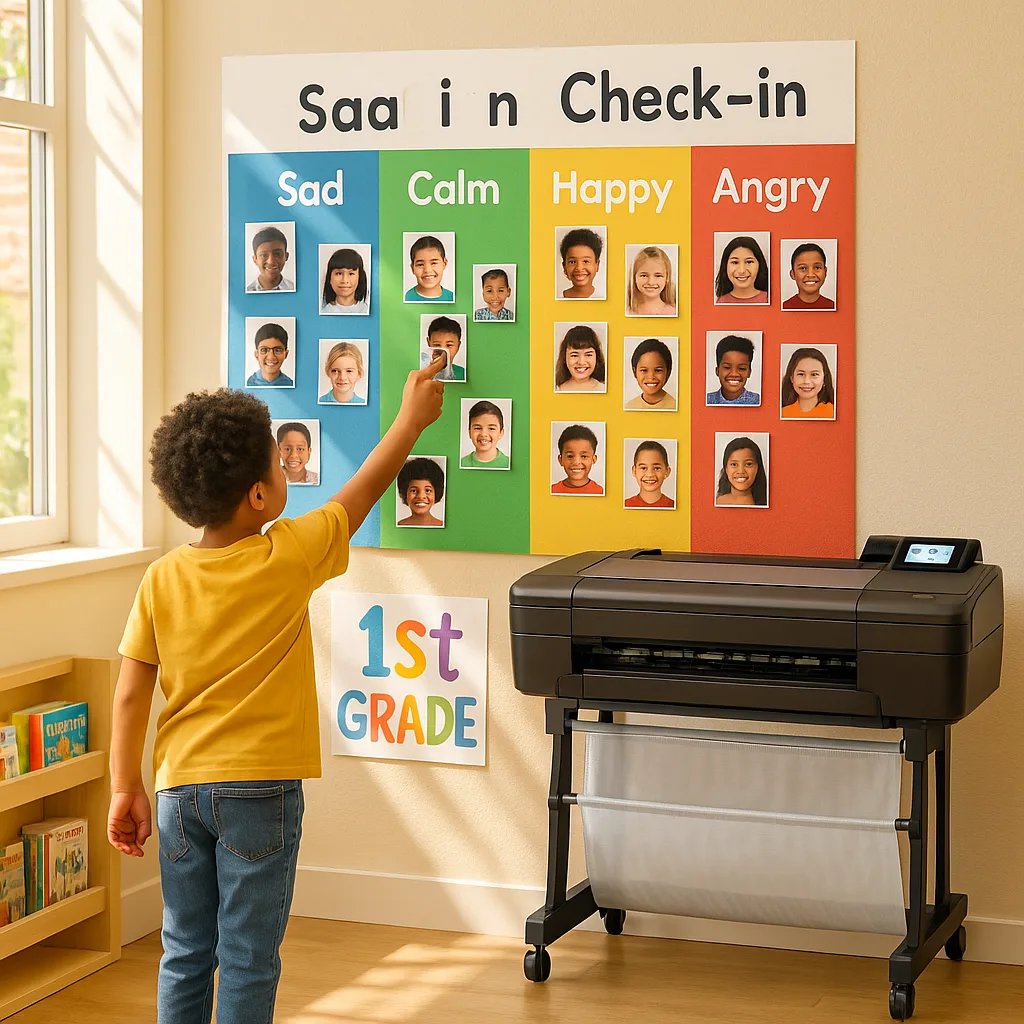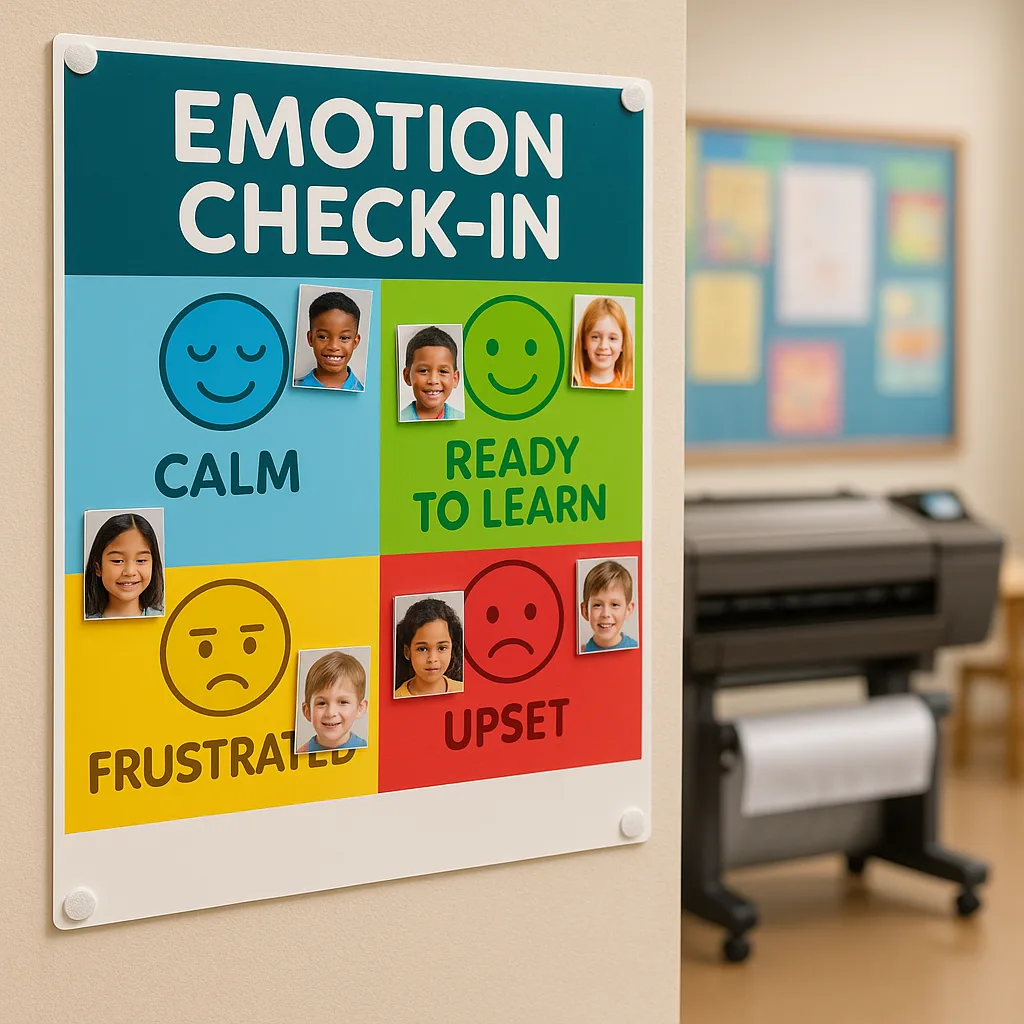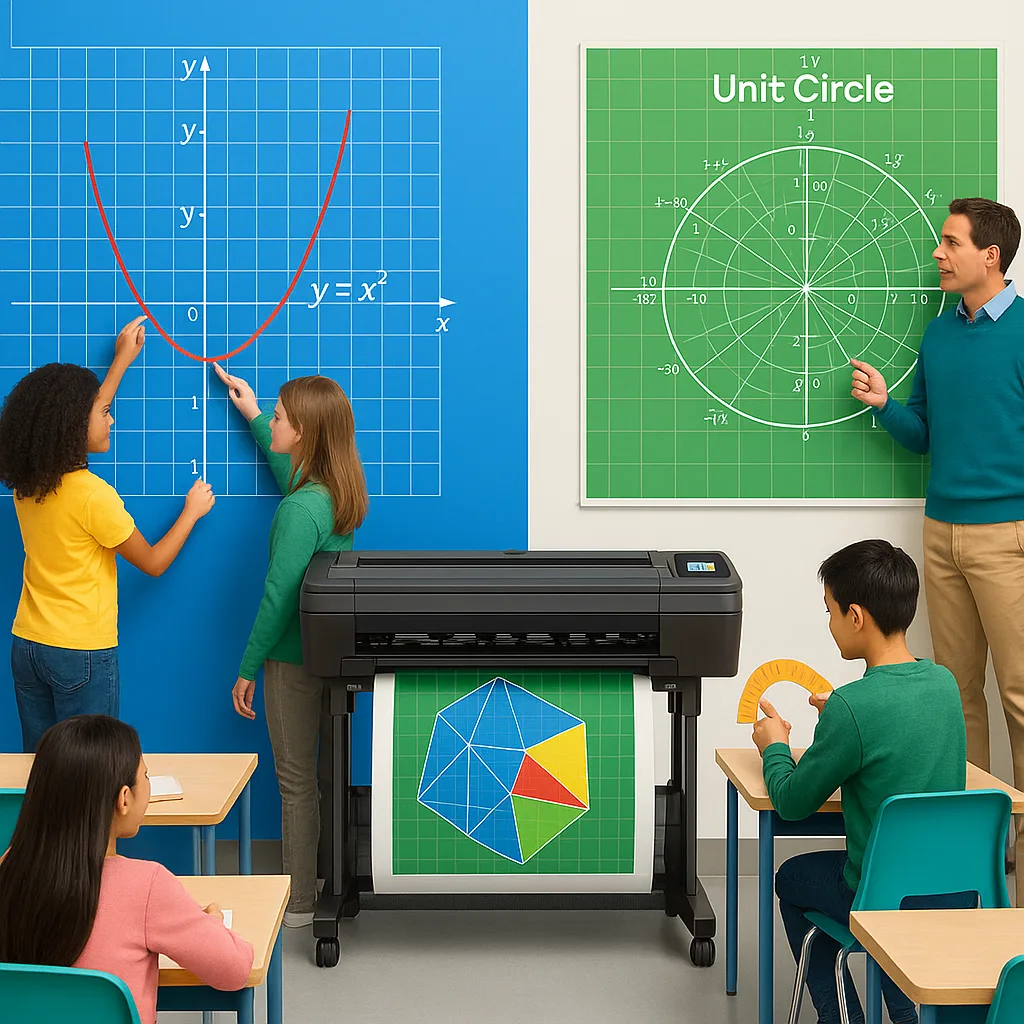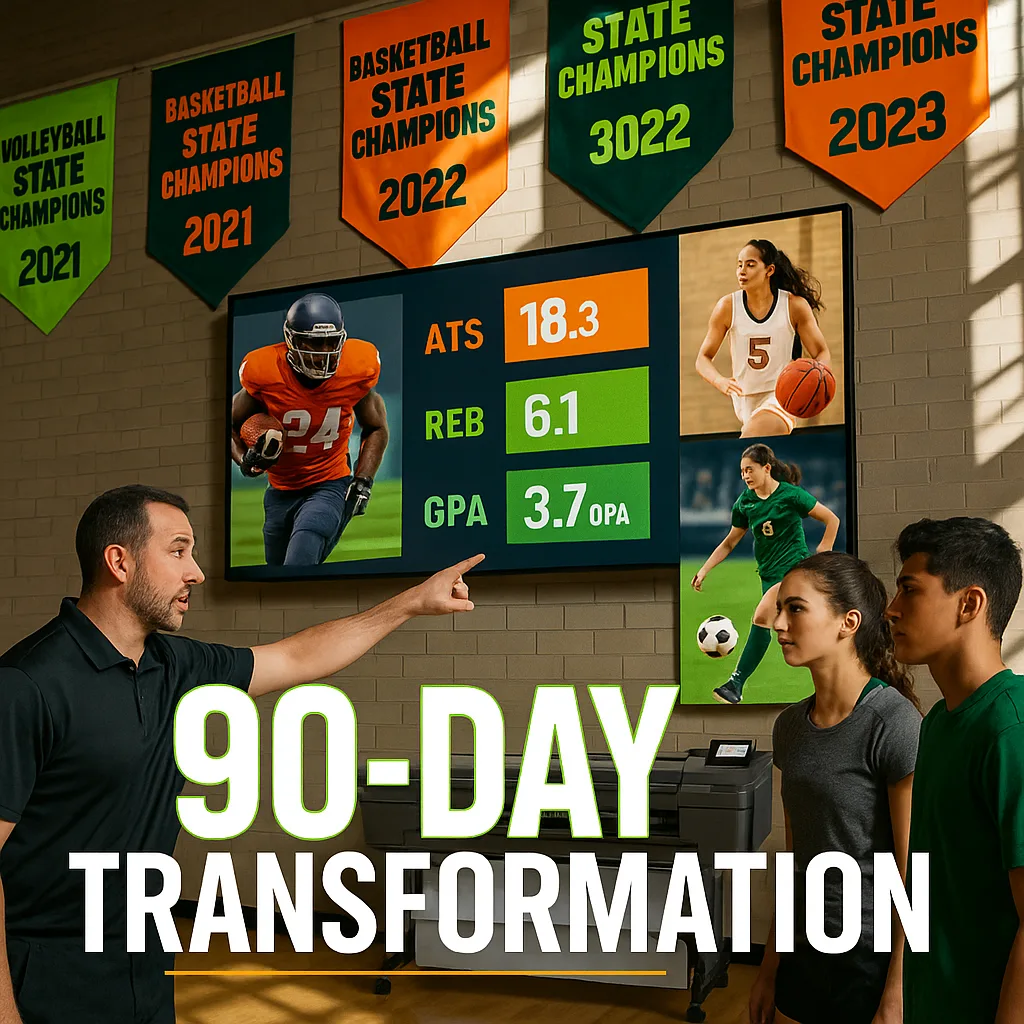
Picture this: Maya, usually my quietest first-grader, confidently walks to our emotion check-in wall and moves her photo magnet to “excited” because she finally mastered tying her shoes. This simple interaction replaced what used to be a crumpled worksheet stuffed in her desk. That’s the magic of transforming traditional SEL activities into interactive visual experiences with the best printer for posters SEL activities.
Why Traditional SEL Worksheets Fall Short
After three months of teaching, I noticed a pattern. Therefore, I started tracking where those carefully photocopied feelings worksheets ended up. Most landed in backpacks, never to return. Even worse, students who needed emotional support most often struggled with the writing component. Research from the Collaborative for Academic, Social, and Emotional Learning (CASEL) shows that interactive SEL activities increase engagement by 67% compared to paper-based methods.
Moreover, traditional worksheets create a disconnect. Students complete them once and move on. However, emotions change throughout the day. Static papers can’t capture these shifts or provide the ongoing support our learners need.

Creating Your Interactive SEL Wonder Wall
Transforming your classroom starts with the right tools. For instance, the Education Express 36 Poster Printer allows you to create durable, colorful displays that withstand daily student interaction. Here’s how I designed my first emotion check-in station:
Emotion Check-In Station Design
First, I created a large poster featuring emotion zones inspired by the Zones of Regulation framework. Using vibrant colors—blue for calm, green for ready to learn, yellow for frustrated, and red for upset—helps students quickly identify their feelings. Next, I laminated individual student photos with magnets attached. Throughout the day, students move their photos between zones as needed.
The cost-effectiveness of printing these materials in-house amazed me. Instead of purchasing expensive pre-made charts, I customize designs to match my students’ needs and classroom theme.
Materials You’ll Need
– Large-format poster paper (I recommend the Satin Photo Paper for durability)
– Laminator for protecting interactive elements
– Velcro dots or magnetic strips
– Student photos or name cards
– Clear storage pockets for moveable pieces
Best Printer for Posters SEL Activities: Setup Guide
Setting up your interactive SEL space requires thoughtful planning. Position displays at student eye level. For my first-graders, that’s about three feet high. Additionally, ensure adequate space for multiple students to interact simultaneously without crowding.
Step-by-Step Installation Process
1. Choose Your Wall Space: Select an area with minimal distractions but easy access throughout the day
2. Print Your Base Posters: Use your color poster maker machine to create vibrant backgrounds
3. Add Interactive Elements: Attach velcro strips or magnetic backing for moveable components
4. Create Student Pieces: Print and laminate individual student markers
5. Establish Routines: Introduce the system during morning meeting
The beauty of using a quality poster printer lies in the ability to iterate. When something doesn’t work, simply design and print a new version overnight.
Conflict Resolution Flowcharts That Actually Work
Traditional conflict resolution often involves lengthy discussions that young students struggle to follow. Instead, I created a visual flowchart students can physically trace with their fingers. Starting with “What happened?” at the top, arrows guide students through reflection questions and resolution strategies.
Designing Your Flowchart
My flowchart includes these key decision points:
– Was anyone hurt? (Physical or feelings)
– Did you use your words first?
– What could you do differently?
– How can you make it better?
Each decision point features simple icons and minimal text. Subsequently, students can navigate the process independently or with a peer mediator. The lifetime design service helped me create custom icons matching our classroom’s visual vocabulary.
Building Mindfulness Pathways
Physical movement enhances mindfulness practice, especially for elementary learners. Therefore, I designed a mindfulness pathway that winds around our classroom perimeter. Students literally walk through breathing exercises, gratitude prompts, and calming visualizations.
Color Poster Maker Machine for Sensory Elements
Using a color poster maker machine opens endless possibilities for sensory-rich displays. For example, I print:
– Textured patterns for tracing activities
– Nature scenes for visualization exercises
– Counting graphics for breath work
– Affirmation cards in calming colors
The demo video shows how easily teachers create these materials without design experience.
Implementation Strategies for Different Grade Levels
Early Elementary (K-2) Applications
Younger students need concrete, visual representations. Hence, I use:
– Picture-based emotion cards
– Simple two-choice decision paths
– Large, colorful graphics with minimal text
– Tactile elements like textured papers
Upper Elementary (3-5) Adaptations
Older students benefit from more complex interactions:
– Emotion intensity scales (1-10)
– Multi-step problem-solving flowcharts
– Journaling prompts integrated with wall displays
– Peer feedback systems using sticky notes
Middle School Modifications
Adolescents require age-appropriate designs:
– Sophisticated color schemes
– Private reflection spaces
– Digital integration with QR codes
– Student-created content opportunities
Maximizing Your Investment with the Best Printer for Posters SEL Activities
Quality equipment makes sustainable SEL programming possible. The 5-year warranty ensures your investment continues supporting students long-term. Additionally, calculating the cost per print reveals significant savings compared to purchasing pre-made materials.
Budget-Friendly Tips
– Start with one interactive wall and expand gradually
– Laminate base posters for multi-year use
– Create seasonal overlays rather than complete redesigns
– Share designs with grade-level teams
– Use the drag-and-drop Canva integration for quick updates
Measuring Success and Student Response
After implementing interactive SEL walls, I tracked several metrics. First, office referrals for peer conflicts decreased by 40%. Second, students self-reported feeling more confident expressing emotions. Most importantly, parents noticed children using SEL vocabulary at home.
Data Collection Methods
– Photo documentation of wall interactions
– Simple tally sheets for usage frequency
– Student surveys about helpfulness
– Behavior incident tracking comparisons
– Parent feedback forms
Troubleshooting Common Challenges
Every classroom innovation faces obstacles. Here’s how I addressed common issues:
Space Limitations
Small classrooms require creative solutions. Try:
– Rotating displays weekly
– Using hallway walls with permission
– Creating folding displays for flexible use
– Maximizing vertical space with tiered designs
Student Misuse
Establish clear expectations from day one. Furthermore, assign “wall helpers” who model appropriate use. Natural consequences work better than punishment—students who misuse materials help create replacements.
Maintaining Engagement
Refresh your displays quarterly. The flexibility of having your own color poster maker machine means you can respond to student interests immediately. For instance, when my class became obsessed with butterflies, I created a metamorphosis-themed emotion journey.
Getting Started Tomorrow
Ready to transform your classroom? Start small with these steps:
1. Choose One Activity: Select your highest-need SEL skill
2. Sketch Your Design: Use paper and pencil first
3. Request a Quote: Call 866-788-7900 for personalized recommendations
4. Create a Prototype: Test with a small group before full implementation
5. Iterate Based on Feedback: Refine your design using student input
Beyond the Basics: Advanced Interactive Elements
Once you master simple check-ins, explore these advanced features:
QR Code Integration
Link physical displays to digital resources. Students scan codes for:
– Calming music playlists
– Guided meditation videos
– Extended activity instructions
– Parent communication tools
Collaborative Art Projects
Transform individual SEL work into community displays. Each student contributes one piece to a larger emotional landscape. This builds both individual skills and classroom cohesion.
Data Visualization Walls
Older students create graphs showing classroom emotion trends. Subsequently, they analyze patterns and suggest environmental improvements. This meta-cognitive approach deepens SEL understanding.
The Long-Term Impact
Three years into using interactive SEL walls, the transformation amazes me. Former students visit specifically to use our emotion check-in station. Parents report children creating similar systems at home using construction paper. Most rewarding? Watching Maya, now a confident fourth-grader, mentor younger students through conflict resolution using our visual flowchart.
Investing in the best printer for posters SEL activities isn’t just about pretty walls. It’s about creating sustainable systems that support emotional growth daily. Instead of one-time worksheets, we build living resources that evolve with our students. That’s the real wonder of wonder walls—they grow alongside our learners, providing consistent support through every emotional up and down.
Ready to transform your classroom? The customer stories from other educators will inspire your journey. Remember, every interactive wall starts with a single poster. What will yours say?





